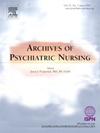韩国女性抑郁症患病率及其相关因素:首尔的一项横断面研究
IF 2.2
4区 医学
Q1 NURSING
引用次数: 0
摘要
抑郁症是一种常见的精神健康障碍,其特征是持续的悲伤和兴趣的丧失。症状包括食欲改变、睡眠障碍、疲劳和幸福感下降。本研究评估了韩国女性抑郁症的患病率,并检查了与其发生相关的因素。方法本研究利用首尔妇女与家庭基金会于2022年收集的调查数据,重点关注19岁及以上的女性,以评估她们的心理健康状况。采用双变量分析和多元逻辑回归模型对数据进行分析。结果本研究纳入1015名年龄在19-71岁的韩国女性,总体抑郁症患病率为19.9%。19-39岁的女性患病率最高(28.2%),而40-59岁的女性患病率为15.0%,60-71岁的女性患病率为12.6%。健康状况不佳的人(45.1%)、对生活不满意的人(40.0%)和自尊心低的人(38.2%)的抑郁率尤其高。与有配偶者相比,独居者患抑郁症的相对风险高2.75倍,健康状况不佳者高3.73倍,对生活不满者高3.35倍,自卑者高3.18倍。结论:本研究考察了与韩国女性抑郁症相关的社会人口学特征、社会经历和自我认知因素。在健康状况不佳、对生活不满和自尊心低的妇女中,患病率尤其高。有效的保健和福利政策对于改善妇女健康、提高生活质量和降低抑郁症发病率是必要的。本文章由计算机程序翻译,如有差异,请以英文原文为准。
Prevalence of depression and its associated factors among Korean women: A cross-sectional study in Seoul
Background
Depression is a common mental health disorder characterized by persistent sadness and a loss of interest. Symptoms include changes in appetite, sleep disturbances, fatigue, and reduced well-being. This study assessed the prevalence of depression among Korean women and examined the factors associated with its occurrence.
Methods
This study utilized survey data collected in 2022 by the Seoul Foundation of Women and Family, focusing on women aged 19 and older to assess their mental health. Bivariate analysis and multiple logistic regression models were conducted to explore the data.
Results
This study included 1015 Korean women aged 19–71, with an overall depression prevalence of 19.9 %. Women aged 19–39 had the highest prevalence (28.2 %), compared to 15.0 % among those aged 40–59 and 12.6 % among those aged 60–71. Depression rates were particularly high among those in poor health (45.1 %), those dissatisfied with life (40.0 %), and those with low self-esteem (38.2 %). The relative risk of depression was 2.75 times higher among those living alone compared to those living with a spouse, 3.73 times higher among those in poor health, 3.35 times higher among those dissatisfied with life, and 3.18 times higher among those with low self-esteem.
Conclusions
This study examined sociodemographic characteristics, social experiences, and self-perception factors associated with depression among Korean women. The prevalence was particularly high among women with poor health, life dissatisfaction, and low self-esteem. Effective health and welfare policies are necessary to improve women's health, enhance quality of life, and reduce depression rates.
求助全文
通过发布文献求助,成功后即可免费获取论文全文。
去求助
来源期刊
CiteScore
3.70
自引率
0.00%
发文量
131
审稿时长
160 days
期刊介绍:
Archives of Psychiatric Nursing disseminates original, peer-reviewed research that is of interest to psychiatric and mental health care nurses. The field is considered in its broadest perspective, including theory, practice and research applications related to all ages, special populations, settings, and interdisciplinary collaborations in both the public and private sectors. Through critical study, expositions, and review of practice, Archives of Psychiatric Nursing is a medium for clinical scholarship to provide theoretical linkages among diverse areas of practice.

 求助内容:
求助内容: 应助结果提醒方式:
应助结果提醒方式:


